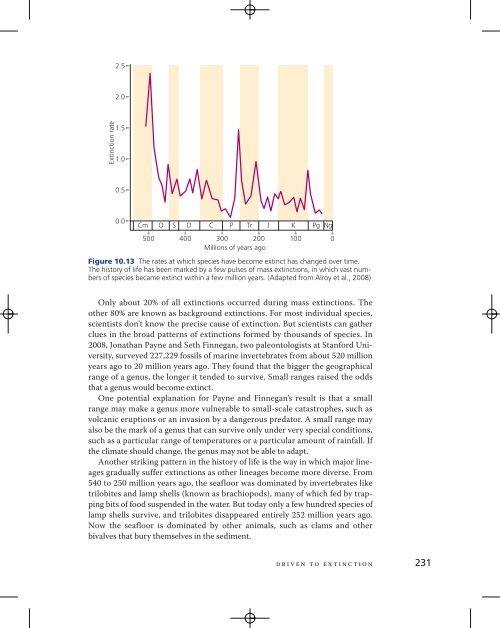Reprinted from The Tangled Bank: An Introduction to Evolution by ...
Reprinted from The Tangled Bank: An Introduction to Evolution by ...
Reprinted from The Tangled Bank: An Introduction to Evolution by ...
You also want an ePaper? Increase the reach of your titles
YUMPU automatically turns print PDFs into web optimized ePapers that Google loves.
Extinction rate<br />
2.5<br />
2.0<br />
1.5<br />
1.0<br />
0.5<br />
0.0<br />
Cm O S D C P Tr J K Pg Ng<br />
500<br />
400 300 200 100 0<br />
Millions of years ago<br />
Figure 10.13 <strong>The</strong> rates at which species have become extinct has changed over time.<br />
<strong>The</strong> his<strong>to</strong>ry of life has been marked <strong>by</strong> a few pulses of mass extinctions, in which vast numbers<br />
of species became extinct within a few million years. (Adapted <strong>from</strong> Alroy et al., 2008)<br />
Only about 20% of all extinctions occurred during mass extinctions. <strong>The</strong><br />
other 80% are known as background extinctions. For most individual species,<br />
scientists don’t know the precise cause of extinction. But scientists can gather<br />
clues in the broad patterns of extinctions formed <strong>by</strong> thousands of species. In<br />
2008, Jonathan Payne and Seth Finnegan, two paleon<strong>to</strong>logists at Stanford University,<br />
surveyed 227,229 fossils of marine invertebrates <strong>from</strong> about 520 million<br />
years ago <strong>to</strong> 20 million years ago. <strong>The</strong>y found that the bigger the geographical<br />
range of a genus, the longer it tended <strong>to</strong> survive. Small ranges raised the odds<br />
that a genus would become extinct.<br />
One potential explanation for Payne and Finnegan’s result is that a small<br />
range may make a genus more vulnerable <strong>to</strong> small-scale catastrophes, such as<br />
volcanic eruptions or an invasion <strong>by</strong> a dangerous preda<strong>to</strong>r. A small range may<br />
also be the mark of a genus that can survive only under very special conditions,<br />
such as a particular range of temperatures or a particular amount of rainfall. If<br />
the climate should change, the genus may not be able <strong>to</strong> adapt.<br />
<strong>An</strong>other striking pattern in the his<strong>to</strong>ry of life is the way in which major lineages<br />
gradually suffer extinctions as other lineages become more diverse. From<br />
540 <strong>to</strong> 250 million years ago, the seafloor was dominated <strong>by</strong> invertebrates like<br />
trilobites and lamp shells (known as brachiopods), many of which fed <strong>by</strong> trapping<br />
bits of food suspended in the water. But <strong>to</strong>day only a few hundred species of<br />
lamp shells survive, and trilobites disappeared entirely 252 million years ago.<br />
Now the seafloor is dominated <strong>by</strong> other animals, such as clams and other<br />
bivalves that bury themselves in the sediment.<br />
driven <strong>to</strong> extinction 231

















